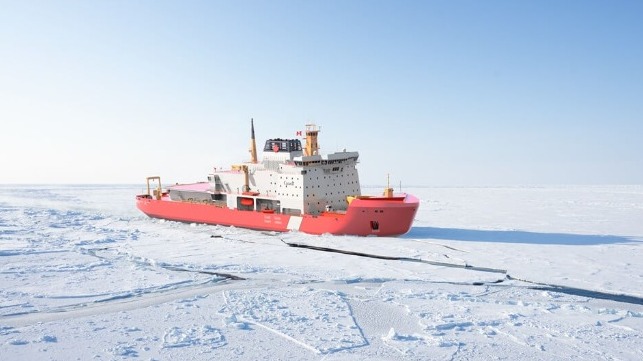Seaspan Finishes Welding Tests for Heavy Icebreaker Construction

Vancouver-based shipbuilder Seaspan has completed a "prototype" hull block for the Canadian Coast Guard's future polar icebreaker to validate its forming and welding techniques, and in a statement Thursday, the firm said that the effort was worthwhile. Heavy icebreakers haven't been built in North America in generations, and both the U.S. Coast Guard and the Canadian Coast Guard are working with shiupbuilders to relearn how to work with the specialized steel and extra-heavy plate required to construct these complex vessels.
Heavy icebreakers face some of the most difficult operating conditions on the planet, on land or at sea. Air temperatures can be as low as -40 F. The hull and frame are exposed to extreme slamming and vibration from riding up on top of the ice, crushing it, and then pushing through the debris. The structure has to hold up to these rigors for the service life of the vessel - and if past life extensions are any indicator, this could be 50 years or more.
These service specifications require a high-strength steel with good low-temperature properties - in this case, EH50, which has a higher tensile strength and better resistance to impact at extremely low temperature.
Some of the plate for the icebreaker will be up to 2.4 inches thick, posing unique challenges for forming and weld quality. Seaspan has set up its own certified test lab on site to evaluate steel and weld quality with a fast turnaround.
In June 2023, Seaspan set out to determine what it would take to build one block of the icebreaker. That project is now complete, the yard says, and lessons have been learned on the required processes, procedures, equipment and skills. These lessons are informing improvements in the ship's design for manufacturing, the yard said.
“Having the opportunity for our engineering and production teams to work collaboratively to construct this Prototype Block very early in the design process was beneficial not only to Seaspan, but also to our customer and our cross-country supply chain," said Martin Edwards, Chief Program Officer at Seaspan.
While its shipbuilding workforce has been busy with Canadian government contracts, Seaspan has been supplementing its own workboat fleet with imported vessels. The firm operates tugs, barges and ferries in domestic trade, and has longstanding relationships with high-quality specialty workboat yards in Turkey. Recent deliveries include HaiSea Wamis, the world's "first fully electric harbor tug," which is owned and operated by a joint venture between Seaspan and the Haisla Nation.
